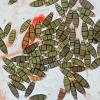
18-12-2025 21:17
Pol DebaenstThe identification took me to Byssonectria deformi

15-12-2025 07:09
 Danny Newman
Danny Newman
indet. Rutstroemiaceae sp. on unk. fallen leavesMc

19-12-2025 10:10
Patrice TANCHAUDBonjour, récolte réalisée en milieu dunaire, a

18-12-2025 17:23
 Bruno Coué
Bruno Coué
Bonjour,je serais heureux d'avoir votre avis sur c

18-12-2025 18:07
Margot en Geert VullingsThese plumes were found on rotten wood.They strong

17-12-2025 18:35
 Michel Hairaud
Michel Hairaud
Bonjour à tous/Hi to everyone I am passing along

15-12-2025 15:48
 Danny Newman
Danny Newman
Melanospora cf. lagenaria on old, rotting, fallen

15-12-2025 15:54
 Johan Boonefaes
Johan Boonefaes
Unknown anamorph found on the ground in coastal sa

15-12-2025 21:11
 Hardware Tony
Hardware Tony
Small clavate hairs, negative croziers and IKI bb
 Hi forum,
Hi forum,I am posting this Dothideomycete on the behalf of Paul Leroy who recently found it on wild plum stones (Prunus cerasifera) in the vicinity of Tours (France).
Ascomata are subglobose 0.5–0.6 mm diam, half immersed with a stout neck. The neck is broadly rounded or slightly laterally flattened, typically with a slit-like or more rarely Y-shaped ostiole. The wall is black, pseudoparenchymatous, thick and leathery, much thinner and less pigmented in the immersed part.
Asci are bitunicate and fissitunicate, short-stipitate, cylindrical to fusiform, with uniseriate overlaping ascospores tending to become biseriate in the mid-part. Apex with a distinct refractive annulus, well seen by contrast in Congo red. Hamathecium of narrow trabeculate pseudoparaphyses. Ascospores 35–38 x 8–9 µm, fusiform slightly inequilateral, 5-euseptate, olivaceous brown at fresh state, end cells smaller and paler, wall verrucose, without sheath.
We considered Trematosphaeria and Lophiostoma in which it might have been placed according to old concepts of these genera but without success. Because of the well-developed ostiolar necks and cylindrical asci with a refractive apical annulus we also considered Navicella but in this genus ascospores are distoseptate and the hamathecium is different.
The unusual substrate and the distinctive morphology of this fungus may remind you something we missed.
Thanks for your suggestions.
Cheers,
Jacques & Paul
Salut Jacques,
Te voilà collé ! Ca rassure.
J'aurais conclu que c'est un asco du complexe Navicella, comme toi.
Je suppose que tu as cherché du côté de Fabre ?
Amuse toi bien !
Alain

There is Lophiostoma oreophilum Speg. in Berlese (Icone Fungorum vol. 1, p. 11, Tab. VII, Fig. 3) which possess such ascospores with 5-euseptate and end cells smaller and paler, 30-35 x 8-10 µm.
Christian

je n'avais pas pensé à consulter Berlese.
L. oreophilum est en effet une une piste mais il est lignicole et dans le protologue (Saccardo) il est dit que le substrat est coloré d'un vert qui rappelle Chorociboria. C'est quand même une piste.
J'ai parcouru Berlese et j'ai trouvé un joli Melanomma sur noyaux, M. nuclearium et sa variété majus, mais ils ne ressemblent pas au champignon de Paul.
Paul, fais un effort, trouve des champignons qui existent dans les livres!
Amitiés,
Jacques




